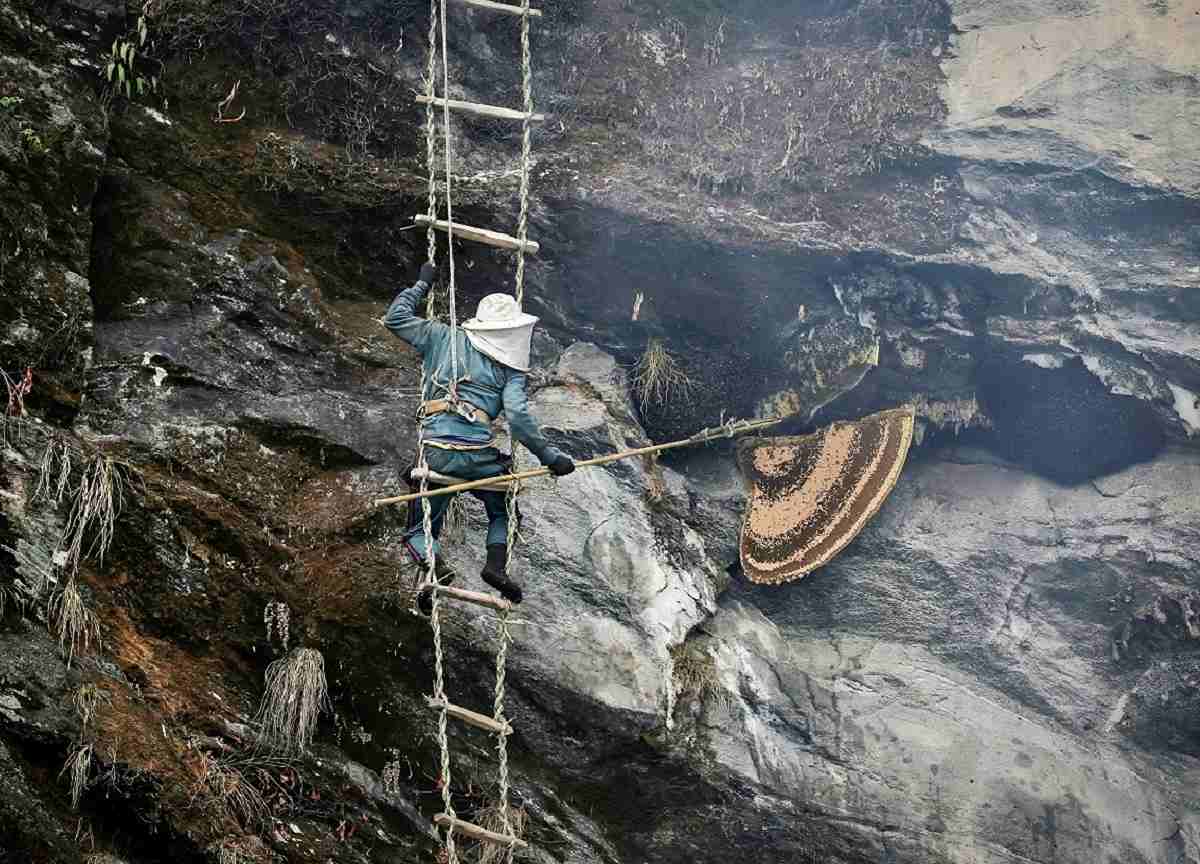
Aita Prasad Gurung cuts a honeycomb while harvesting honey from the cliff near Taap in Lamjung, Nepal, on May 29.
15:58 JST, June 20, 2024
TAAP, Nepal (Reuters) — Aita Prasad Gurung dangled off a cliff in Nepal, carefully manipulating a long pole with a blade at its end to cut away chunks of honeycomb after Himalayan bees fled the fumes from a fire set to drive them from their homes.
The 40-year-old wore a white hat with a net swathing his face to protect against stings as he hung 50 meters off the precipice on a handmade ladder, braided from bamboo strands, to reach the bee colonies.
“It is fraught with danger of falling,” said Aita, whose community has traditionally harvested honey from hives perched hundreds of feet off the ground. “One must extract honey and stay safe at the same time.”
Now the generations-old craft is increasingly under threat as some experts say rising temperatures brought by climate change disrupt the growth of bees, the availability of their food and even pollination of plants.
“There were about 35 hives last year,” said another member of the community, Chitra Bahadur Gurung, 49. “We barely have 15 now.”
For generations, the Gurung community in Taap, about 175 kilometers west of the capital, Kathmandu, and other villages in the nearby districts of Lamjung and Kaski, have scoured the steep Himalayan cliffs for honey.
Earlier, the villagers joined in the ritual slaughter of a red rooster, separating its feet and feathers as an offering to the cliff god, to seek forgiveness for taking the honey from the giant bees, known to scientists as Apis laboriosa.
The honeycomb extract, also known as “mad honey” for some intoxicating qualities that can cause hallucinations, sells for 2,000 Nepali rupees ($1.5) a liter, but the villagers rule out overharvesting as a reason for falling collections.
The proceeds, split among the group, are drying up as the number of hives declines, said the villagers, although some earn a living from growing crops of rice, corn, millet and wheat.
With less honey available to collect every year, income from the pursuit has declined over the past decade, said 41-year-old Hem Raj Gurung.
“We harvested about 600 kilograms of honey 10 years back, which fell to about 180 kilograms last year and is just about 100 kilograms this year,” he said.
Some experts blame climate change, driven by a global rise in temperatures, as a major factor in the decline, but other contributors are deforestation, diversion of water from streams and rivers for hydroelectric dams and use of pesticides.
Temperatures in the Himalayas, home to the planet’s tallest peaks, range higher than an average global increase of 1.2 C above pre-industrial levels, United Nations data and independent research show.
Global studies show that a temperature rise of even one degree affects the growth of bees, the availability of their food and cross pollination of plants, said Suruchi Bhadwal of India’s Energy and Resources Institute (TERI).
Research showed climate change was disrupting the food chains for bees and the flowering of plants, affecting populations of both across the world, added Bhadwal, the head of earth science and climate change at the institute.
“In terms of the patterns and what we’re talking about, I think the patterns are the same in Nepal,” she said.
Climate change was affecting the Himalayan cliff bees in different ways, said Surendra Raj Joshi, a specialist in resilient livelihood at the International Centre for Integrated Mountain Development (ICIMOD) in Kathmandu.
“Too much or too little rain, intense or erratic rain, and long dry spells or high fluctuations in temperature, put stress on honeybees to maintain colony strength and honey stocks,” he said.
Lifecycle changes in plants also cause early or late flowering and fluctuations in secretion of nectar and honeydew, he said, adding, “The most visible indicator of the climate change is the erratic weather.”
Some experts say floods and landslides can cause habitat loss and shrink the areas where bees can forage for food.
"World" POPULAR ARTICLE
-

8 Japanese Nationals Stranded on Indonesia’s Sumatra Island
-

U.S. Senate Resolution Backs Japan, Condemns China’s Pressure
-

China to Impose Sanctions on Shigeru Iwasaki, Former Head of Japan’s Self-Defense Forces, Who Serves as Adviser to Taiwan’s Executive Branch
-

South Korea’s Top Court Dismisses Nippon Steel Appeal in Lawsuit over Requisitioned Worker
-

75% of Myanmar People Reject Army’s Political Involvement, According to Survey Conducted by Aid Organization
JN ACCESS RANKING
-

Tokyo Economic Security Forum to Hold Inaugural Meeting Amid Tense Global Environment
-

Keidanren Chairman Yoshinobu Tsutsui Visits Kashiwazaki-Kariwa Nuclear Power Plant; Inspects New Emergency Safety System
-

Imports of Rare Earths from China Facing Delays, May Be Caused by Deterioration of Japan-China Relations
-

University of Tokyo Professor Discusses Japanese Economic Security in Interview Ahead of Forum
-

Japan Pulls out of Vietnam Nuclear Project, Complicating Hanoi’s Power Plans

























